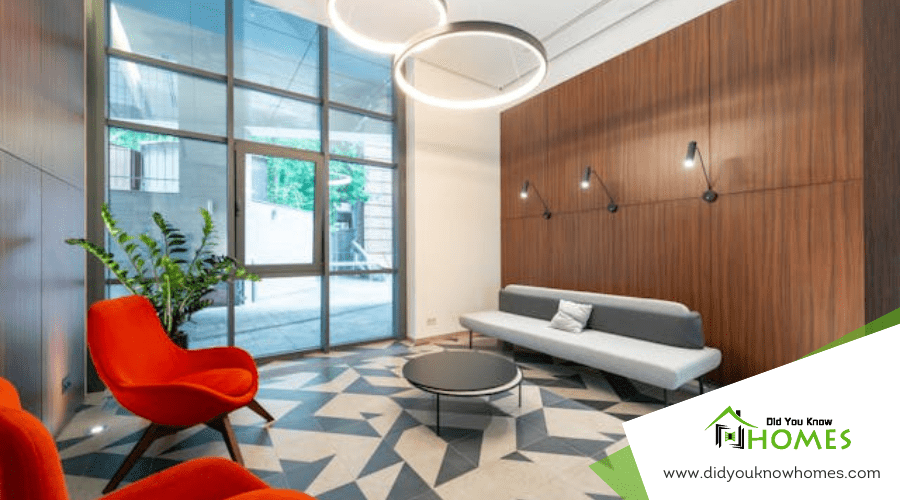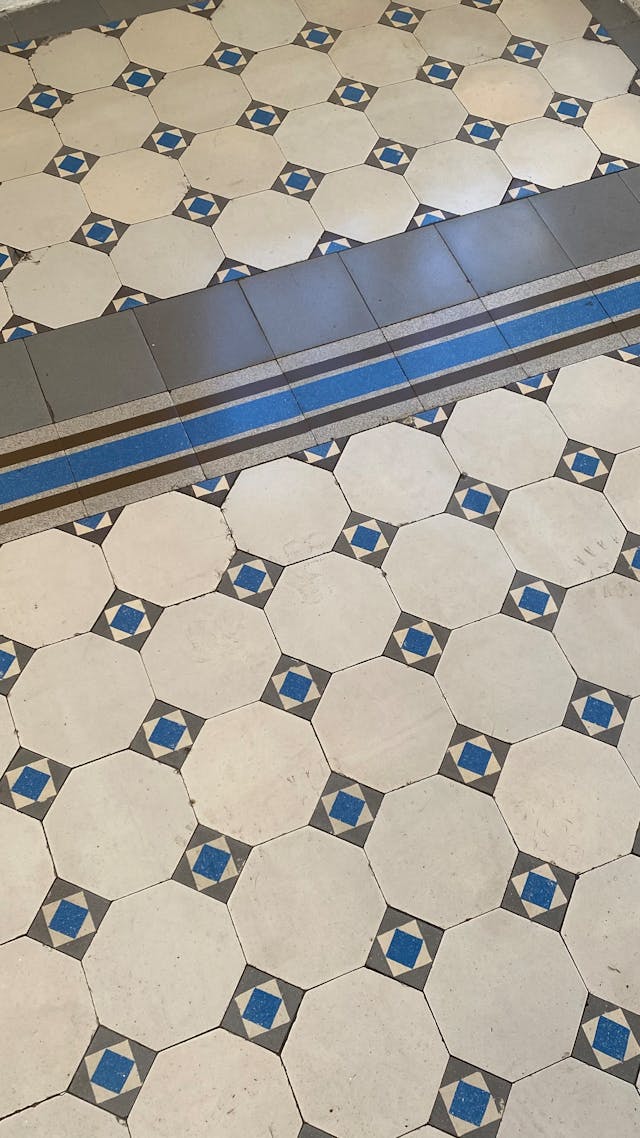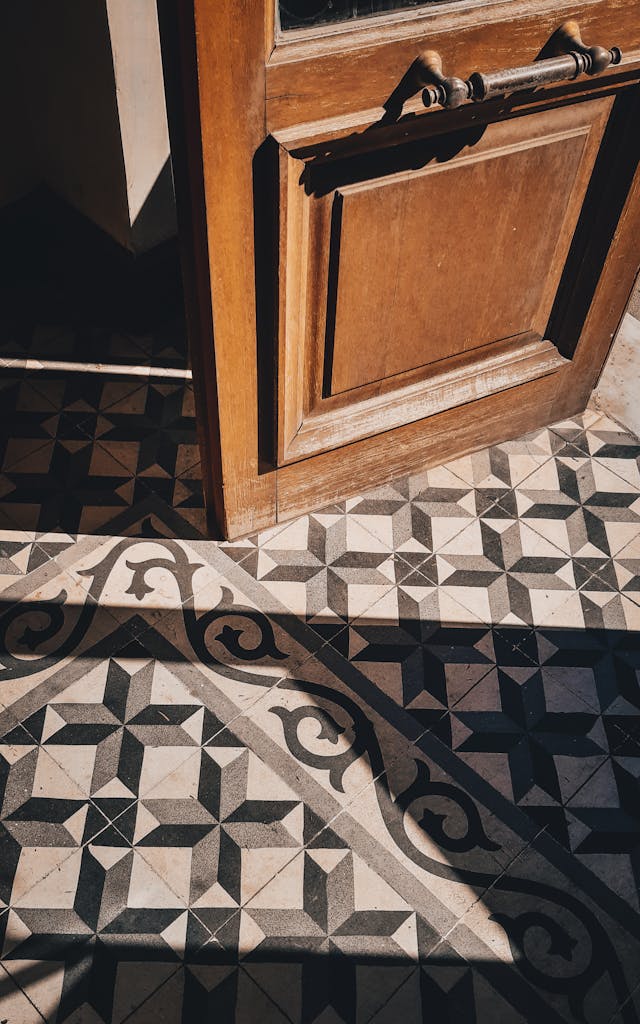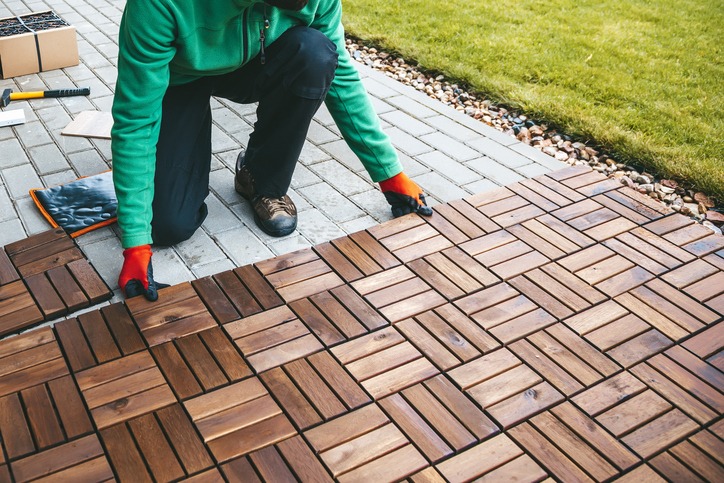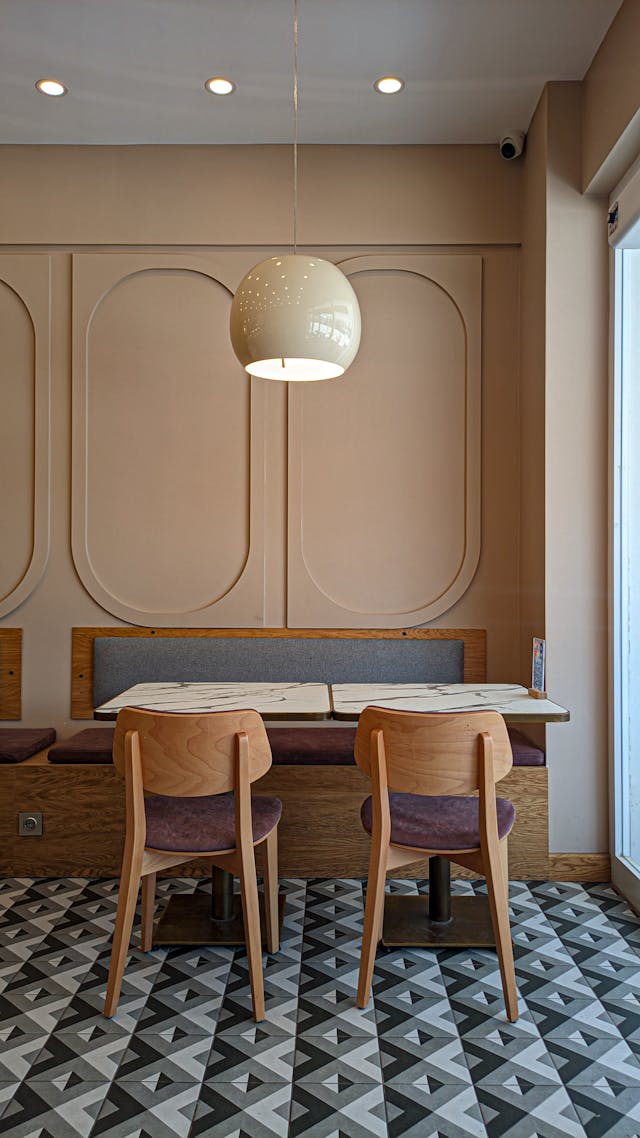You’ve probably noticed geometric and patterned floor tiles popping up everywhere. This isn’t new; Victorian tiles trace back to the Middle Ages. Thanks to Herbert Minton and the Industrial Revolution, these designs became more accessible and varied. Today, they offer you a blend of old-world charm and modern functionality. Geometric tiles aren’t just pretty; they enhance aesthetics, boost creativity, and can make spaces seem larger. With materials like ceramic, porcelain, and natural stone, there’s a tile for every taste and need. If you select thoughtfully, considering room theme and tile durability, you’ll create a stunning, engaging space. There’s much to explore in maximizing their potential.
Key Takeaways
- Geometric and patterned tiles gained popularity due to their aesthetic appeal and ability to enhance spatial perception.
- The affordability of geometric tiles increased with the Industrial Revolution, making them accessible to a broader audience.
- Advances in tile design, particularly by innovators like Herbert Minton, contributed to the variety and complexity of patterns available.
- The versatility and durability of materials like ceramic, porcelain, and natural stone have expanded the use of patterned tiles in various settings.
- The trend reflects a blend of old-world charm and modern design needs, allowing for creative expression in both residential and commercial spaces.
The Evolution of Tile Design
While Victorian tiles hark back to the Middle Ages, their evolution greatly shaped modern home aesthetics. Herbert Minton revolutionized this field, bringing the charm of encaustic tiles from a bygone era to the masses. His innovation wasn’t just about reviving the past; it was about setting the stage for the future of flooring.
The Industrial Revolution was a game-changer. It made the production of single-color geometric tiles more efficient, making what was once a luxury affordable for more people. This shift wasn’t just about accessibility; it was about variety. Victorian tiles blossomed in the mid-19th century, moving beyond the classic checkerboard to an array of shapes, sizes, and patterns. This variety meant homeowners could personalize their spaces like never before.
Today, Victorian tiles aren’t just a nod to the past; they’re a statement piece in modern homes. The use of porcelain tile, with its durability and sleek finish, bridges the gap between old-world charm and contemporary design needs. It’s this blend of history and modernity that keeps Victorian tiles not just relevant but fashionable, offering a timeless and impactful design element for any home.
Benefits of Geometric Tiles
You’ll find that geometric tiles not only boost your room’s aesthetic appeal but also allow for a burst of creative expression. Their unique patterns improve spatial perception, making your space appear more dynamic and engaging. It’s a simple yet effective way to elevate your interior design game.
Enhances Aesthetic Appeal
Geometric floor tiles instantly elevate a room’s aesthetic appeal by introducing dynamic visual interest and texture. The variety of tile shapes—from triangles and hexagons to diamonds—brings a modern and contemporary twist to any space. These unique patterns and designs aren’t just eye-catching; they’re also durable and resilient, capable of guaranteeing heavy foot traffic, spills, and stains. This secures their beauty lasts, making them a smart choice for both style and function. Plus, with a wide range of colors and patterns available, you’ve got endless options to match your design preferences. Choosing geometric tiles not only boosts your home’s aesthetic but also its value, offering a stylish yet durable flooring solution that stands the test of time.
Promotes Creative Expression
Harnessing the versatility of geometric floor tiles allows you to express your unique style and add a personal touch to your home’s design. These tiles offer a creative outlet, letting you showcase your distinctive design preferences and infuse personality into any space. With their modern and contemporary aesthetic, geometric tiles enhance the visual appeal of floors through intricate patterns and shapes. They’re not just about looks; their mix-and-match capability means you can craft custom designs, opening up endless possibilities for interior decor. Whether it’s in the kitchen, bathroom, entryway, or living space, incorporating geometric tile design can elevate a room’s overall look and create an alluring focal point that draws the eye.
Improves Spatial Perception
By cleverly incorporating geometric tiles, you can greatly enhance the perception of space in any room. These tiles create visual illusions, making areas feel more expansive or dynamic. Whether you’re aiming to segment a room into specific areas or spotlight architectural details, geometric patterns are your go-to. They don’t just add depth and dimension; they also carve out unique spaces without physical barriers. Playing with shapes and angles introduces a modern, sophisticated vibe, effortlessly elevating your interior design. In addition, geometric tiles infuse your space with character and interest, all while keeping everything balanced and cohesive. It’s a strategic move that marries aesthetics with functionality, transforming your space into something both beautiful and practical.
Types of Patterned Tiles
When exploring the world of patterned floor tiles, you’ll find a diverse array of options including ceramic, porcelain, natural stone, vinyl, and cement, each with its unique appeal and design possibilities. Here’s a closer look at what makes each type stand out:
- Ceramic Tile: Versatile in colors and patterns, ceramic tile is a popular choice for those looking to add personality to their spaces. Its adaptability allows for a customization that can fit any design vision, making it a go-to for homeowners and designers alike.
- Porcelain Tile: Known for its durability, porcelain is ideal for high-traffic areas. Despite its toughness, it doesn’t skimp on style, offering an array of decorative choices.
- Natural Stone Tile: For a touch of luxury, natural stone tiles like marble and granite are unparalleled. Each piece is a unique work of art, adding an exclusive and elegant flair to your floor.
- Vinyl and Cement Tiles: Offering cost-effective and bold options, vinyl and cement tiles bring vibrancy and diversity to flooring. The wide range of colors and patterns in vinyl and the handmade charm of cement tiles can transform any space into a statement.
Choosing the right patterned tile involves considering these options and their distinctive qualities.
Selecting the Right Tiles
Understanding the variety of patterned floor tiles available, it’s now time to focus on selecting the right ones for your space. Consider the room’s layout, design theme, and the atmosphere you’re aiming to create. The right tiles can transform a space, making it essential to choose ones that complement your style, whether it’s modern, traditional, or eclectic.
Think about color, pattern, size, and shape. These elements should harmonize with your room’s current aesthetic and serve the function of the space effectively. For instance, larger patterns might suit spacious areas, while intricate designs can add depth to smaller rooms.
Material matters too. Ceramic, porcelain, natural stone, vinyl, and cement tiles each bring their own benefits, ranging from durability to ease of maintenance. Your choice should align with the room’s usage and your lifestyle.
Don’t hesitate to seek professional advice. Experts can offer invaluable insights on the selection and proper installation of your chosen tiles, ensuring a stunning and lasting outcome. Finally, keep an eye on design trends. Incorporating geometric patterns, encaustic-style tiles, or a mix-and-match approach can keep your space up-to-date and visually engaging.
Cost Comparison
Evaluating the cost of patterned floor tiles requires careful consideration of various factors to guarantee you’re making a wise investment in your space. The allure of geometric and patterned tiles lies not just in their aesthetic appeal but also in the vast array of design options they offer. However, this variety means prices can vary widely. Here’s what impacts the cost:
- Material: The base material of the tiles can have a substantial impact on the price. Ceramic tiles tend to be more cost-effective than porcelain or natural stone.
- Size: Larger tiles often cost more, both regarding the product price and installation fees.
- Complexity of Pattern: More intricate designs may involve higher manufacturing costs, reflecting in the price tag.
- Manufacturer: Branded tiles might come with a premium price due to their assured quality and unique design options.
Outdoor Application
After exploring the cost factors of patterned floor tiles, let’s focus on how they can elevate outdoor spaces. Outdoor-specific tiles are crafted to endure the elements. Materials like slate, granite, or limestone aren’t just essential; they bring an unmatched elegance to any exterior. When you’re aiming to transform your patio or garden, these durable and stylish tiles stand up to the task.
Adhering to the manufacturer’s maintenance guidelines is essential to guaranteeing your outdoor tiles last. It’s not just about choosing a design that catches the eye; it’s also about safeguarding that beauty against the test of time and weather.
Installing these tiles outdoors isn’t a critical process. While we’re not diving into the specifics of installation here, know that proper groundwork, from surface preparation to sealing, is vital for outdoor application. This ensures the tiles not only look good but are functionally sound, enhancing your space’s design and utility.
Choosing outdoor patterned floor tiles isn’t just an aesthetic decision. It’s a practical one, too. These tiles add a layer of design sophistication to your exterior spaces while supporting the overall vibe of your home.
Installation Guide
To guarantee your geometric and patterned floor tiles stand out, begin with preparing the surface properly. You’ll need to perfect tile laying techniques for that seamless look, and don’t overlook grouting and sealing to safeguard your work. These steps are crucial to a striking, long-lasting finish.
Preparing the Surface
Before you place your geometric and patterned floor tiles, it’s essential to make sure the surface is clean, dry, and level. Proper surface preparation is key to a successful installation. Here’s how to get started:
- Remove any existing flooring to expose the subfloor. Inspect it for damage and make necessary repairs.
- Clean the surface thoroughly to remove all debris, dust, and contaminants.
- Apply appropriate primers and leveling compounds as recommended by the tile manufacturer. This ensures a flat and ready surface.
- Let the surface dry completely before proceeding. Moisture can undermine the adhesive, leading to tile movement or cracking.
Following these steps for surface preparation guarantees your tiles will look fantastic and last for years.
Tile Laying Techniques
Mastering tile laying techniques is crucial for guaranteeing your geometric and patterned floor tiles look stunning and endure the test of time. Proper methods, from precise cutting to applying adhesive correctly, are foundational. You’ve got to plan your layout carefully, honoring the design options your tiles offer. Precision is your best friend here; it ensures seamless patterns and sidesteps any visual inconsistencies that might mar your project’s beauty.
Don’t skimp on following the manufacturer’s guidelines, as this keeps warranties intact and ensures tiles perform well long-term. For complex patterns or tricky layouts, considering a professional might save you headaches. Ultimately, the right approach to laying tiles elevates the aesthetic and durability of your floor, making your design options shine.
Grouting and Sealing
After laying your geometric and patterned floor tiles, it’s essential to grout and seal them correctly to guarantee durability and a polished appearance. This step is important in protecting your design possibilities and ensuring your floor remains stunning over time. Here’s a quick guide:
- Grouting: Fill gaps between tiles with a cement-based mixture to stabilize and prevent moisture infiltration.
- Sealing Grout: Protects from stains and water damage, extending the floor’s lifespan.
- Choose the Right Sealer: Penetrating sealers for natural stones, epoxy for high-traffic areas.
- Follow Manufacturer Instructions: Ensures a successful, long-lasting installation.
Proper grouting and sealing amplify the beauty of your tiles, making maintenance easier and preserving the integrity of your design.
Maintenance Tips
To keep your geometric and patterned floor tiles looking their best, start by cleaning them regularly with mild detergent and water. This important step is vital for maintaining the vibrant patterns and colors of your tiles. Harsh chemicals and abrasive cleaners are a big no-no, as they can dull the finish and damage the intricate designs. Instead, opt for a soft mop or cloth during your routine cleaning to avoid scratching the surface.
Don’t overlook the significance of sealing your grout lines. This preventive measure not only protects against stains but also makes your maintenance efforts a breeze. Sealed grout is less likely to harbor dirt and grime, keeping your tile work looking pristine with less elbow grease.
Spills and stains are inevitable, but how you handle them can make all the difference. Tackle these mishaps promptly to prevent them from seeping into your tiles and setting. By addressing spills and stains quickly, you guarantee they don’t become stubborn blemishes that mar the beauty of your flooring.
Current Design Trends
Having covered how to maintain your geometric and patterned floor tiles, let’s explore the latest design trends that are shaping spaces with flair and creativity. The world of interior design is constantly evolving, and tiles with geometric shapes are at the forefront, transforming homes and commercial spaces alike. Here’s what’s currently catching the eye:
- Geometric Shapes Galore: Hexagons, rhomboids, chevrons, and mosaics are leading the charge. These shapes provide a modern twist to traditional spaces, offering uniqueness and a fresh perspective.
- Material Matters: From ceramic and porcelain to natural stone, vinyl, and cement, the variety of materials available allows for endless creativity. Each material brings its own texture and vibe, setting the tone for the entire space.
- Bold and Beautiful: Bold patterns, intricate designs, and contrasting colors are in vogue. They create dynamic and visually stunning floors that capture attention and make a statement.
- Mix, Match, and Personalize: The trend of mixing and matching different patterned tiles lets you customize your space. It’s all about reflecting your personal taste and design preferences, ensuring your space is truly your own.
Embrace these trends and infuse your spaces with personality and style.
Frequently Asked Questions
Are Patterned Floor Tiles on Trend?
They’re a key part of design evolution, adding a modern twist to any room. They offer a unique, dynamic look that’s both stylish and contemporary.
What Is the History of Decorative Tiles?
Decorative tiles have a deep history, starting from the Middle Ages. They’ve always held cultural significance, evolving through the ages. You’ve seen them go from elite status symbols to widely accessible, hygiene-friendly options for homes.
What Is the History of Floor Tiles?
Floor tiles have evolved markedly due to manufacturing evolution. Starting with simple designs, advancements allowed for intricate patterns that you see today, making them a staple in modern homes for both aesthetics and practicality.
What Are the Patterned Tiles Called?
They’re known for their bold, geometric shapes. Think hexagons, chevrons, and rhomboids. They add a unique flair to any floor or wall.
Conclusion
You’ve navigated the exciting world of geometric and patterned floor tiles, discovering their evolution, benefits, and the vast array of types available. Now, you’re equipped to select the perfect tiles that align with your budget and outdoor space needs. With a handy installation guide and maintenance tips at your fingertips, you’re all set. Embrace the current design trends and transform your space with these eye-catching tiles, ensuring it stands out with a vibrant, enduring charm.
